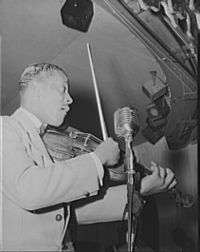Ray Nance
| Ray Nance | |
|---|---|
|
Ray Nance in Duke Ellington's orchestra (1943) | |
| Background information | |
| Birth name | Ray Willis Nance |
| Born | December 10, 1913 |
| Origin | Chicago, Illinois, United States |
| Died | January 28, 1976 (aged 62) |
| Genres | Jazz |
| Occupation(s) | Trumpeter, vocalist, violinist |
| Instruments | Trumpet, vocals, violin |
| Associated acts | Duke Ellington |
Ray Willis Nance (December 10, 1913, in Chicago – January 28, 1976, in New York City) was a jazz trumpeter, violinist and singer. He is best remembered for his long association with band leader Duke Ellington.
Early years
Nance led his own band in Chicago from 1932 to 1937. Then, he worked with Earl "Fatha" Hines from 1937 to 1939; and from 1939 to 1940 he worked with Horace Henderson.
Ellington tenure
Ellington hired Nance to replace trumpeter Cootie Williams in 1940. Nance's first recorded performance with Ellington was the Fargo, North Dakota ballroom dance.[1] Shortly after joining the band, Nance was given the trumpet solo on the first recorded version of "Take the "A" Train," which became the Ellington theme, a major hit and a jazz standard. Nance's "A Train" solo is one of the most copied and admired trumpet solos in jazz history. Indeed, when Cootie Williams returned to the band more than twenty years later, he would play Nance's solo on "A Train" almost exactly as the original.
Nance was often featured on violin and was the only violin soloist ever featured in Ellington's orchestra (especially noteworthy is his violin contribution to the original 1942 version of "The 'C' Jam Blues"). He is also one of the better known male vocalists associated with Ellington's orchestra. On later recordings of "It Don't Mean a Thing (If It Ain't Got That Swing)", Nance took the previously instrumental horn riff into the lead vocal, which constitute the line "Doo wha, doo wha, doo wha, doo wha, yeah!" He was often featured as vocalist on "Jump for Joy," "Just A-Sittin' and A-Rockin'" and "Just Squeeze Me (But Please Don't Tease Me)". His multiple talents (trumpet, violin, vocals and also dancing) earned him the nickname "Floorshow".
Nance was absent from the Duke Ellington Orchestra for around 3-4 months in 1946, including the date of the famous Carnegie Hall concert. In 1949, Ray showed up, along with Ellington sidemen Russell Procope, Johnny Hodges and Sonny Greer on several Ivory Joe Hunter sessions for King Records of Cincinnati.
Post-Ellington years
He left the Ellington band in 1963 after having played alongside his predecessor Cootie Williams for a year. By that time, Nance had switched from trumpet to cornet. Before the Berlin Concert in 1965 or in the Copenhagen Concert that took place on the same year, he returned to Duke's orchestra for a final hurrah. After all that, he left the orchestra for good, and toured and recorded in England in 1974.[1]
Nance made a few recordings as a bandleader, and also recorded or performed with Earl Hines, Rosemary Clooney, Jaki Byard, Chico Hamilton and others.[1]
Discography
As leader
- Body and Soul (Solid State, 1969)
- Huffin' 'n' 'puffin' (MPS, 1971)
As sideman
With Jaki Byard
- Jaki Byard with Strings! (Prestige, 1968)
With Earl Hines
- Rosetta (Jazz Archives, 1937–1939 selections)
- 1937–1939 (Classics, 1937–1939 performances)
- Harlem Lament (Sony, 1937–1938 selections featuring Nance)
- Piano Man! (ASV, includes c. 1937–1939 RCA selections)
- Earl Hines and the Duke's Men (Delmark, 1944–1947 performances)
- 1942–1945 (Classics, 1942–1945)
With Horace Henderson
- Horace Henderson 1940, Fletcher Henderson 1941 (Classics, 1992)
With Duke Ellington
- The Duke at Fargo, 1940: Special 60th Anniversary Edition (Storyville, 1940 performance)
- Duke Ellington and His Great Vocalists (Sony, c. 1940s)
- Cabin in the Sky Soundtrack (Rhino, 1942 performance)
- Indispensable Duke Ellington, Vol. 11–12 (1944–1946) (RCA, 1944–1946 performances) or The Best of the Complete Duke Ellington RCA Recordings, 1944–1946) (RCA, 1944–1946 performances)
- Ellington Uptown (includes Harlem Suite, Controversial Suite, Liberian Suite) (Columbia, 1947, 1951, 1952 performances)
- Masterpieces by Ellington (Columbia, 1950, 1951 performances)
- Ellington '55 (Capitol, 1955) or Jazz Profile (Blue Note, 1950s, 1960s performances)
- A Drum Is a Woman (Columbia, 1956)
- Blue Rose (With Rosemary Clooney) (1956)
- Historically Speaking (1956)
- Ellington at Newport (1956)
- Such Sweet Thunder (1957)
- Black, Brown and Beige (Columbia, 1958)
- Live at the Blue Note (1958)
- Newport 1958 (Columbia, 1958)
- Festival Session (1959)
- Blues in Orbit (1959)
- Anatomy of a Murder (1959)
- Jazz Party (1959)
- Piano in the Background (1960)
- The Nutcracker Suite (1960)
- Swinging Suites by Edward E. and Edward G. (1960) (Peer Gynt Suite/Suite Thursday)
- First Time! The Count Meets the Duke (Columbia, 1961)
- Afro-Bossa (1961)
- Midnight in Paris (1962)
- Duke Ellington Meets Coleman Hawkins (Impulse!, 1962)
- The Great Paris Concert (Atlantic, 1963)
- Duke Ellington's Jazz Violin Session (Atlantic, 1963)
- My People (1963)
- The Symphonic Ellington (1963)
- Ellington '66 (1965)
- Concert in the Virgin Islands (1966)
- In the Uncommon Market (1966)
With Johnny Hodges
- Ellingtonia '56 (Norgran, 1956)
- Duke's in Bed (Verve, 1956)
- The Big Sound (Verve, 1957)
- Not So Dukish (Verve, 1958)
Notes
- 1 2 3 "Ray Nance | Biography, Albums, & Streaming Radio". AllMusic. Retrieved 2016-05-05.
References
- Lambert, Eddie (1998), Duke Ellington: A Listener's Guide, Lanham, MD: Scarecrow Press, ISBN 978-0-8108-3161-2.
